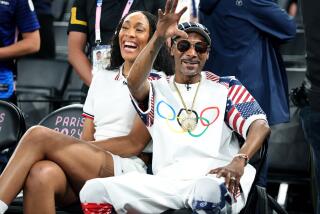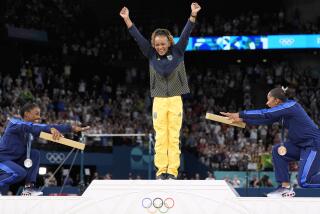Commentary : Pan Am Games Are Big in Latin America, but in U.S. It’s ‘Who Cares?’
One day last week, the daily newspaper El Universal of Caracas, Venezuela, carried 19 wire service stories on the Pan American Games. It’s competitor, El Nacional, had 26.
On the same day, The Salt Lake City Tribune, Arkansas Gazette, Omaha World-Herald and Seattle Post-Intelligencer each ran one story. And not a single patron of Runyon’s, the famous New York sports bar, asked about the games.
“In this place, it’s nil,” Runyon’s co-owner James Costello said of Pan Am fever. “No one asks to watch it on TV, so I assume they’re not interested. The concentration here is on the baseball pennant races and the upcoming football season.”
Are people at least talking about the games?
“The Pan Am Games? No, not one word,” Costello said. “There was some talk when the kid hit a home run against the Cubans. . . . And that’s about the extent of it.”
While the Pan Am Games are one of the biggest shows going in much of Latin America, the United States has given this quadrennial sports extravaganza of the Americas a tepid reception.
Even though the Pan Am Games are in the United States for the first time since 1959, even though they are billed as a precursor to the Korean Olympics and even though the United States has set an all-time medals record, pro football and baseball hold the headlines.
CBS-TV scheduled 26 hours of live coverage from Indianapolis, but all of it was for the games’ three weekends, none during midweek.
Nielsen ratings, showing the percentage of TV households watching the games, were 4.4 for the first Saturday and 3.2 on Sunday as CBS competed with ABC’s PGA golf championships. Last weekend, the ratings were 4.7 on Saturday and 5.2 on Sunday, the first full weekend of NFL exhibition games. The Pan Am Games end this weekend.
“That’s about on target,” CBS spokesman Mark Carlson said. “When you’re involved in summer programming, opposite things like baseball pennant races, it fits in about where we expected it would.”
Ratings like these may have been expected, but they’re not generally considered any better than mediocre by the industry. The NFL exhibition game between Denver and Los Angeles on the first Sunday of the games, for example, had a rating of 10.1.
“We’ve been showing them on TV,” said Jim Rittenberg, manager of one of Chicago’s biggest sports bars, Ditka’s, owned by Bears Coach Mike Ditka. “But we split our screens, and they seem to watch the other screens. Chicago is Bear crazy, and the games happen to coincide with the opening of the Bears’ exhibition season. Everything is Bears, Bears, Bears.”
And for the Pan Am Games, that’s bad news.
“It’s really been tough. We’ve got the Prairie State Games here, too, involving four or five states,” Rittenberg said. “It’s the same type of thing as the Pan Am Games, and we can’t get anybody interested in that either.”
The U.S. Olympic Committee points out, however, that it accredited 1,573 U.S. journalists for these Pan Am Games, compared with less than 75 four years ago in Caracas and about the same in Puerto Rico in 1979.
On the other hand, the USOC issued 1,589 U.S. credentials for the Olympic Festival a month ago in North Carolina. The Olympic Festival involves only American athletes in similar events.
“Right now, we’re talking about the beginning of the football season and some very exciting pennant races,” Mike Moran, USOC information director, said. “I think in some cases the Pan Am Games aren’t getting as much coverage in terms of inches of print as the Olympic Festival, but that was a month ago and there wasn’t as much competition from pro sports.
“Even so, there’s been much more coverage from American organizations than in the previous two games I’ve been to.”
Interest among Latin American countries is understandable . Jose Luis Lozano of Argentina had five gold medals in speed roller skating and was the object of adoration in his homeland. Silvia Poll had eight medals in swimming--three gold, three silver and two bronze--and her native Costa Rica was abuzz. Lourdes Medina had five medals, three gold and two silver, in rhythmic gymnastics, and her name was in common use among households in Cuba.
The Pan Am Games were being heavily covered by Mexico City’s 15 daily newspapers, and Mexican specialties such as race-walking, rowing, fencing and equestrian events rivaled the Mexican Baseball League championships between Mexico City and Nuevo Laredo in scope of coverage.
Television in Mexico was limited to the CBS weekend feed, and there were complaints not only about the small amount of coverage but also that it concentrated on U.S. specialties such as diving, basketball and baseball.
In Puerto Rico, more than two-thirds of the TV and radio sports broadcasts were dedicated to the games, while newspapers also played them prominently. In San Juan, Pan Am Games stories such as Puerto Rico’s gold medal in women’s judo, the boxing team, basketball and opening ceremonies received front-page attention.
Even in Latin America, however, there were pockets of apathy. In Brazil, Latin America’s largest country, interest was relatively low. None of the major commercial television networks were carrying the games live. Finally, a low-rated educational station picked them up.
Although Brazil ranked fourth overall in medals behind the United States, Canada and Cuba going into the final weekend of the games, coverage in the major newspapers was low key--much the same as in the United States.
“This sounds real bad, but the only thing we’ve heard much about the games was the drug scandal,” said Mindy Allen, manager at Bobby Valentine’s Sports Gallery, a bar and restaurant in Milford, Conn. “Obviously, we’re really baseball oriented here.”
Valentine’s is owned by Texas Rangers Manager Bobby Valentine.
The last time the games were held in the United States was 28 years ago in Chicago. Rittenberg thinks such a choice of sites might have helped quell Pan Am apathy this year.
“I think they picked the wrong city,” Rittenberg said. “Hey, Indianapolis isn’t exactly a media mecca. I’ve been down there. It’s a beautiful facility, in Indianapolis . . . but I think if they’d picked New York or Chicago or Los Angeles, maybe it would have been different.”
Four years from now, the games will be in Havana, Cuba. Viva la Apatia.
More to Read
Go beyond the scoreboard
Get the latest on L.A.'s teams in the daily Sports Report newsletter.
You may occasionally receive promotional content from the Los Angeles Times.










